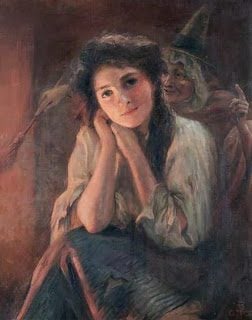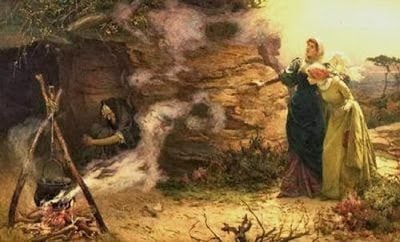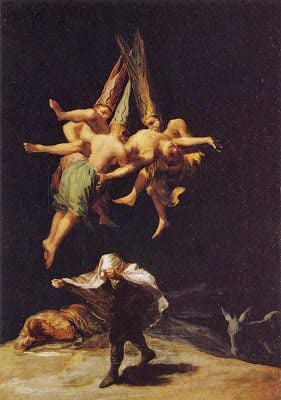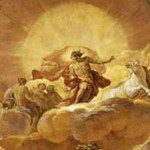 Last month I put together a little list about 10 Important Traditional Witches. For the purposes of that article I defined a Traditional Witch as “either a lineaged practitioner from an established tradition (like an Alexandrian) or a follower of a family or village tradition.” This allowed me to choose from a broad spectrum of Witches past and present, many of them people I’d been interested in writing about for a good long while but hadn’t found a way to turn that interest into a thousand word article. Most of the definitions I use online are rather generous, and are more likely to be inclusive than exclusive. Some see that as a good thing, others as a negative one.
Last month I put together a little list about 10 Important Traditional Witches. For the purposes of that article I defined a Traditional Witch as “either a lineaged practitioner from an established tradition (like an Alexandrian) or a follower of a family or village tradition.” This allowed me to choose from a broad spectrum of Witches past and present, many of them people I’d been interested in writing about for a good long while but hadn’t found a way to turn that interest into a thousand word article. Most of the definitions I use online are rather generous, and are more likely to be inclusive than exclusive. Some see that as a good thing, others as a negative one.
Anytime I put together a list of people I know there is going to be blowback. Some of it’s because people interpret the line “Ten Important” as “The Only Important,” overlooking the fine print. Other times folks get upset when one of their personal favorites aren’t included. I understand that, I’m defensive about my favorites too. What really struck me about some of the criticism I got for the Ten Important Traditional Witches list was how upset people were with how I defined the term “traditional witch.” Often times the article’s working definition was overlooked (or purposefully ignored). Every word and/or phrase we use in the Modern Pagan and Occult Communities is loaded, there’s no real way to write about some of these things without pissing somebody off. That’s one of the reasons I try to include my own definitions in some of my articles. The Ten Important Traditional Witches article even included the words: “What is a Traditional Witch? Opinions vary. For the purposes of this article . . . .” That certainly wasn’t enough.
(I began work on this article last Friday, and it slowly spiraled out of control as many articles do. Blogging is often solitary work, but I thought this article needed a few perspectives outside my own so I asked some of my friends and peers for their own definitions of Traditional Witchcraft. The result is, I think, a much better article.)
PATHEOS PAGAN WRITERS SHARE THEIR DEFINITIONS OF TRADITIONAL WITCHCRAFT
Niki Whiting (A Witch’s Asharam) “Initiation by others and some degree of emphasis on lore and oaths.”
Rua Lupa (Paths Through the Forest) “I personally tend to think of “Traditional Witchcraft” as groups who are generational witches – those who have been doing it for about over three generations. This would be regardless of origin of practice and would especially be those that have incorporated the local region in their practice. Otherwise the practices come across as ‘lacking roots’ so to speak and think of these particular individuals/groups as being in the process of setting down their roots.”
Brandy Williams (Star and Snake) “Twenty years ago in the Northwest we had high priestess meetings discussing this kind of thing. To us, Traditional Witchcraft meant a lineaged succession, which we called a line, tracing to some sort of British antecedent, recognized or not. Gardnerian, Alexandrian, British Traditional (Kingstone/Majestic/Silver Crescent), Georgian, Mohsian, and I think that’s it. An HPS of a Trad Craft line would have a lineaged initiation and a Book of Shadows, lead a coven, and train and initiate. I’ve stopped using the term since it means such different things now, but defer to whoever wants to call themselves Traditional Witches. I call myself a Witch, 1st degree Georgian, 3rd degree Rainbow Serpent which is a non-recognized lineage.”
Peg Aloi (The Witching Hour) “I recall when I first became involved in neopagan witchcraft (as Ronald Hutton calls it) in the 1990s, there was a tacit understanding that “FamTrad” (as it was called) witchcraft was older and somehow more “authentic” than Wicca. But in my experience most “traditions” all have a Wiccan ritual structure and imagery in common and that goes for Druids, Heathens, goddess-worshippers, etc. In other words, it really did all begin with Gardner’s bricolage and plagiarism.”
Sara Amis (A Sense of Place) “Traditional Craft is more folkloric and less like ‘churchy’ organized religion or New Age groups. Whether or not Wicca fits depends very much on where you are standing, but I am intensely wary of any such pronouncements that seem to proceed from an attempt to jockey for position.”
The definition I used in the article reflects how I define myself. I’m a part of a lineaged, initiatory tradition. Many of us, especially here in the United States, refer to that particular practice (and others like it) as British Traditional Witchcraft (BTW). You’ll notice that the phrase British Traditional Witchcraft contains the words Witchcraft and Traditional. By extension then, I consider myself a Traditional Witch. I would never say that BTW Witches are the only Traditional Witches, only that I define them as such.
 I was hoping to find some easy to link to (and quote) definitions online, but many definitions of Traditional Witchcraft are more about what Traditional Witchcraft is not. One particular definition keeps coming up, and it’s one suggested by Michael Howard in his book Children of Cain. Howard’s definition is simple, and by extension broad, but seems to represent a wide range of people who self-identify as Traditional Witches: “any non-Gardnerian, non-Alexandrian, non-Wiccan or pre-modern form of the Craft*, especially if it has been inspired by historical forms of witchcraft and folk magic.”
I was hoping to find some easy to link to (and quote) definitions online, but many definitions of Traditional Witchcraft are more about what Traditional Witchcraft is not. One particular definition keeps coming up, and it’s one suggested by Michael Howard in his book Children of Cain. Howard’s definition is simple, and by extension broad, but seems to represent a wide range of people who self-identify as Traditional Witches: “any non-Gardnerian, non-Alexandrian, non-Wiccan or pre-modern form of the Craft*, especially if it has been inspired by historical forms of witchcraft and folk magic.”
I ALSO ASKED SOME OF MY FRIENDS AND ACQUAINTANCES ONLINE HOW THEY DEFINE TRADITIONAL WITCHCRAFT
Kayla Wilde “While I don’t usually call myself a Traditional Witch, part of my practice does fall beneath the category of what certain people would consider traditional witchcraft. I realize there are quite a few definitions and I would say they are all valid, but it makes it so that specification is required when one throws the term “Traditional Witchcraft” into conversation. When I use the term Traditional Witchcraft to describe my practice I’m referring to witchcraft that is inspired by fairy tales, folklore, and old folk magic practices, and particularly those from early modern Europe, which was roughly between the late 15th to the late 18th century.”
Grave Robyn “Folk magic with some ecstatic practices, heavy on the spirit work and often times mixed with Christianity or other modern neopagan religion . . . . . Folk magic further defined with the power residing in the items used, like herb, stone and wand, not in the practitioner unlike ceremonial magical practices such as LBRP (Lesser Banishing Ritual of the Pentagram).”
Helix (Faery Initiate) “I tend to think of Traditional Witchcraft as craft that is minimally influenced by the New Age movement. I say this without being against the New Age movement; in fact, Reclaiming is directly influenced by a the Human Potential Movement, part of the larger New Age movement, and its focus on social justice, self-healing, and ritual improvisation has been a huge influence on me. But to back up a little… witchcraft influenced by the New Age movement spreads itself through workshops, books, classes, and blogs, not from mouth to ear. It’s more likely to be solitary, because it serves the individual first, and the community second. It’s more interested in self-growth than in practical magic, and it often sees itself as part of a movement that will Save The World, and so is eager to become as public as possible. In contrast, Traditional Craft is usually taught in an apprenticeship or small group, and family-type relationships are considered a necessary part of the teaching container. Traditional Witches often see themselves as serving the community first, and much of what they do may be operant magic for community members (for barter or sometimes for pay). The Traditional Witch is the person you come to with problems when mainstream experts have failed. Traditional Craft is not millennial, and it tends to be at least somewhat secretive because of its view of history (governments, religions, ideologies come and go, sometimes violently, and the best strategy for surviving those times is to hunker down and become invisible). Refinement of the self is often a part of Traditional Craft, but my perception is that it tends to be seen more instrumentally — if you’re not clean in your Self, your magic doesn’t work, and you’re useless to your tribe. New Age Craft sees self-development more as an end in itself.”
Joseph Merlin Nichter “I find that most often there is an connotation of older, which isn’t bad, but it’s not entirely accurate. I’ve heard the term used to mean pre-Wiccan, non-Wiccan, BTL Wicca Vs NAT (New American Trads), but I’ve also heard it used by NATs meaning ‘a tradition of Witchcraft,’ Vs non-tradition or eclectic forms of Witchcraft. As a NAT myself, I’ve also said I practice ‘Traditional Witchcraft,’ meaning, I practice a tradition of Witchcraft or Wicca, although our Trad is barley 10 years old.”
Seamus MacKenzie “Traditional Witchcraft would be a form of Witchcraft not allied with the Gardnerian or Alexandrian forms of what became known as British Traditional Witchcraft. Practitioners of such claim that its less a recreated religious form than a continuance of traditional folk-magick practices of the old viliage Cunning Men and Midwives of rural places where common folk sought out supernatural aid or assistance on achieving their goals. The whole topic surged to light in the sixties when Roy Bowers, writing as ‘Robert Cochrane’ wrote letters to the Pentagram magazine. His letters and movement later gave birth to the 1734 Tradiation of Witchcraft and the Roebuck tradition.”
Howard’s definition very specifically excludes BTW Witches and that exclusion comes up a lot on discussion boards labeled Traditional Witchcraft. Certainly Gerald Gardner’s vision of Witchcraft has been extremely influential, and while I’m quite partial to that vision myself, it’s certainly not the only valid form of Witchcraft. What has always bothered me about that separation between the two streams of thought is how adversarial it sometimes feels. The hardest thing about Howard’s definition for me to reconcile is the inclusion of the phrase “or pre-modern form of the Craft.” That phrase is difficult for me because Gardner thought what he was doing was possibly “pre-modern.” Age doesn’t confer validity anyways, and in addition, every Pagan and/or occultist I know practices a combination of things both contemporary and classic. Ritual techniques often date back centuries, seasonal observances even longer, and most modern magical practices are a combination of ceremonial and folk magic (most cunning-folk had access to grimoires full of ceremonial magic). In some ways the majority of people who use the word Witch to describe themselves are pre-modern to some extent.
The end part of Howard’s definition is exceedingly apt: “especially if it has been inspired by historical forms of witchcraft and folk magic.” Certainly lots of people who identify as a witch have been inspired by folk magic. Folk magic has a long and distinguished history in the Western World, and the word witch does not always imply a form of spirituality. The line about “historical forms of witchcraft” is a bit more problematic because up until pretty recently the word “witchcraft” has nearly always meant black magic. To put it simply witches were users of negative magic, and the word was nearly always used negatively up until the Nineteenth Century. Of course one can find all sorts of inspiration in the magic and practices of people who have been labeled witches over the centuries. Though I don’t believe in Margaret Murray’s The Witch Cult in Western Europe as a credible interpretation of history, I have taken bits out of it and inserted them into rituals. I’m sure Gerald Gardner did the same thing.
 For Traditional Witches who subscribe to a more Howard-like definition many of the choices on my list were met with a great deal of criticism. There were a lot of people who didn’t like my listing of Laurie Cabot, but according to Cabot she was initiated by a group of Witches in the late 1940’s. The point of the article wasn’t to question anyone’s claims. If there was a claim of initiation it was good enough for me.
For Traditional Witches who subscribe to a more Howard-like definition many of the choices on my list were met with a great deal of criticism. There were a lot of people who didn’t like my listing of Laurie Cabot, but according to Cabot she was initiated by a group of Witches in the late 1940’s. The point of the article wasn’t to question anyone’s claims. If there was a claim of initiation it was good enough for me.
I was really surprised that there were individuals angry with my inclusion of Eleanor “Ray” Bone. In my opinion Bone was a great choice for that list because she could arguably be seen as a “Traditional Witch” under any definition of the word. According to Ray she was initiated into the Cumbrian Tradition in 1941, which would obviously be a “pre-modern form of the Craft” since I’m taking “pre-modern” to mean “pre-Gardner.” She was also later initiated by Gardner, but that didn’t make her earlier initiation invalid. In The Encyclopedia of Witchcraft and Neo-Paganism (which is where I got the information for my initial biographical sketch of Bone) mention is made of how Bone came back around to her original earlier practice in the later years of her life:
“Eleanor used ‘low’ or ‘country magic’ rather than the Gardnerian Wicca she had practiced in the 1950’s and slowly returned to the ways she had learnt in Cumbria.”
I hope there aren’t people who believe the term Traditional Witchcraft stands for “being adversarial towards anyone initiated or influenced by Gerald Gardner.” I have nothing but respect for people like Joseph Wilson and Victor and Cora Anderson. There’s also a long history of those Traditional Witches working side by side with more “post-modern” practitioners.
One of my friends once defined Traditional Witchcraft as “something I know when I see it.” To me that’s a pretty apt definition. When someone says they are practicing Traditional Witchcraft** they most likely are. Does the term have certain definitions depending on the context? Certainly, and when I’m a part of a specific group that uses the phrase a specific way I honor that definition. I love Witchcraft in all its forms and will always be fascinated by every strand of the Craft.
*The term “The Craft” is of fairly recent vintage and was another name for Freemasonry. In most circles it’s now short for Witchcraft, but that wasn’t originally the case.
**This link has very little to do with “someone says they are practicing Traditional Witchcraft” but I found it very useful while putting this piece together and wanted to link to it.

















